May 6 – Our Fifth Anniversary – Tuesday
Hollie, Bob, and Rich Wellman went to the Baltimore-Washington Airport to pick up Mark and Pauline Wells to help us crew the boat back to Maine, pick up Rich’s wife Carol, and put Hollie on a plane to Albany to help Amie and be with her for Mother’s Day. An absolutely gorgeous day with sunshine and warm winds!
May 7 – Wednesday
With winds 10 to 20 kts from the south and waves ½ to 1 ft, we actually sailed most of the way from Annapolis to Worton Creek on the east shore of the Chesapeake – Yesssssss!!! Quiet at last - so much more pleasant without the constant noise of the engine. Mark and Bob figured out how to rig the whisker pole to sail wing on wing, which added significantly to the boat speed, at times 9.5 mph. We went under the Chesapeake Bay Bridge (Hwy 50/301) about noon.
With very little room for anchoring in Worton Creek, we picked up an unused mooring ball at a marina in the creek and spent a delightful night, except for a false alarm on the anchor watch because of Bob’s using too small a radius for the alarm circle. He set the anchor watch small because of the poor condition of the mooring pendant and concern the rest of the mooring setup might be in similar condition.
May 8 – Thursday
A second day of almost entirely sailing without the engine – Great!!! Winds were 15 to 20 kts and waves of 1 to 2 ft – making a delightful sail. With a favorable current of a kt or more all day, we made 8.5 to 10.1 mph most of the time. The whisker pole gave us good wing-on-wing sailing again. The current in the C&D Canal was about 2.5 kts, making the sharp turn into the narrow entrance to the anchoring basin at Chesapeake City (about a third of the way into the canal) challenging.
With the anchoring basin too full for another boat, Bob called the Chesapeake City Town Dock number in the Cruising Guide and was told by the lady who answered the phone he could dock for two days (for another weather delay…) at a designated place on the face dock, even though the signs on the dock say “No Docking.” Well, as soon as the dock lines were tied, a man about 60 stormed over to the dock and angrily confronted Bob with “Do you know how to read?” followed immediately by, “Do you see these signs? Do you know what ‘No Docking’ means?”
After finding out that the lady who answered the phone had told Bob to tie up there, he promptly redirected his anger toward her: “She is not responsible for the docks and has no business telling anyone to dock anywhere. I’m going to have a talk with her. I’m the dockmaster here, and I’m the only one who can authorize anyone to tie up to these docks.” After calming down some, the dockmaster told Bob he could stay there for the night but might have to move to the anchoring basin in the morning if another boat, which had that dock space reserved for tomorrow, still wants it. With that, Bob, Mark, and Pauline went to the C&D Canal Museum, then walked around town and found an ice cream shop. The next morning, the dockmaster drove to the docks and yelled to us from his pickup truck that we could stay an extra day; the other good news was that the docks are free – only $5 for water and $10 for electricity (if there were any, as the outlets were all either burned out or the wrong plug configuration).
The C&D Canal was first opened for use in 1829 after 5 years of back-breaking digging and hauling dirt from the 14-mile ditch by over 2,600 workers. Originally only 10 ft deep and 66 ft wide with four locks, the canal is now 35 ft deep and 450 ft wide with no locks. Each of the locks required a large steam engine that pumped over 20,000 gallons per minute to raise the water levels in the locks. The canal can accommodate the largest commercial ships that go into and out of Baltimore or Philadelphia harbors and cuts off many hours from their trips compared with having to go in or out through the bays and around the land by sea. Since 1927, the Army Corps of Engineers has operated and maintained the canal, redesigning and expanding it several times.
May 10 – Saturday
After a day of heavy rain most of the day on Friday, we left Chesapeake City at 4:55 a.m. (yawn….) headed for the Delaware Bay and Cape May. It was eerie leaving in the dark, but the lights along the banks of the C&D Canal were a big help navigating until the sun started to come up and we could see land features. Current was 3+ kts against us in the canal, so we hugged the shore in 15 to 20 ft of water (45 ft in the middle of the canal) where the current was about a knot slower than in the middle.
We entered the Delaware Bay about 7:15 with winds less than 5 kts and waves less than a foot –unusual and ideal conditions for the bay. We had a great sail down the bay with favorable current for the first three hours and got to Utsch’s Marina at 1:45 PM to spend the night and pick up a package Hollie had sent for Pauline. After doing our accumulated laundry, we had dinner out in Cape May and got a good night’s sleep for another early rising the next day.
May 11 – Sunday, Mother’s Day
Up bright and early (well, early anyway…), we cast off lines at 5:45 a.m. and headed up the New Jersey coast bound for Barnegat Bay, which would position us 55 miles from NYC. Again we had ideal conditions – winds on the bow less than 5 kts, waves less than a foot, gentle 2-ft swells, and sun breaking through the overcast. As we left the Cape May Inlet jetties, we were greeted by several dolphins, interpreted by sailors to be a good omen.
However, our good omen was short lived. About 10 a.m., the wind picked up to 20 to 22 kts true (high 20s relative), building the waves to 2 to 4 ft, then 3 to 5 ft, then 4 to 6 ft. By noon, with the waves pounding us, rolling the boat up to 25 degrees, and sending solid water crashing onto the dodger windows and running into the cockpit, with the wind howling, and with a forecast for nasty weather including 9 to 11 ft waves and winds gusting to 35 kts for the next two days, we opted to go into the Atlantic City inlet and anchor for two days to wait out the weather.
May 12 – Monday – A day to remember…
We went to bed Sunday night about 9:30 with the winds in the low 30s gusting to the upper 30s; the anchor watch alarm was on. At 1:30 a.m., the alarm sounded – the anchor had dragged about 50 ft, and the boat was about two boat lengths from Great Catsby as it wildly swung back and forth with winds in the upper 30s gusting into the mid 40s. For the next 20 minutes, Bob used the engine to try to hold the boat into the wind, reducing the swinging and the pull on the anchor. Scope was 8 ½ to 1. The winds were so strong that the boat still swung, but not quite as far or as fast. This seemed to allow the anchor to reset itself, as it held after the engine was turned off.
As a precaution, though, we started a “helm watch,” taking turns at the helm ensuring the anchor did not start dragging again (couldn’t reset the anchor watch alarm without driving the boat back over the anchor, which was not possible in the existing conditions: winds howling; waves 2 to 3 ft, all with whitecaps and a lot of blowing spray; and unable to see the anchor trip line float). We continued this watch until 5:30 pm when the winds subsided to mostly less than 35 kts.
The boat was swinging rapidly back and forth 50 to 60 degrees to each side of the wind, and the wind heeled the boat to each side 15 to 20 degrees, occasionally 23 to 25 degrees, on each swing. Heavy rain was pelting the dodger windows and the side curtains of the cockpit enclosure, blowing into the cockpit through every opening in the enclosure and wetting the entire inside off the cockpit and all of its contents including people. Also, every few minutes, a wave would crash against the windward side of the boat, and the wind would drive the heavy wall of salt water splash against the dodger windows and cockpit side curtains, much of which also got inside the cockpit via the openings in the enclosure. This continued and worsened through the night, the morning, and the early part of the afternoon.
About 10 a.m., the winds had risen to the upper 40s gusting into the 50s (the maximum gust we saw was 54.6 kts) – too much for the anchor to hold, and it started dragging again, putting the boat precariously close to The Great Catsby. Since we couldn’t put out more scope without getting closer to Catsby, we elected to reset the anchor in a different location. Mark drove the boat very skillfully in the heavy wind; Bob went on deck with life jacket and harness on, tethered to the jackline, to release and reattach the anchor snubber line and raise and lower the anchor; and Pauline relayed signals, as the headsets didn’t work in the howling wind.
Resetting the anchor took three tries in miserable, bitter conditions. The third set seemed firm, but after 20 minutes, it was obvious the anchor was again dragging, even with a scope of 8 ½ to 1. So Bob went out on deck again and increased the scope to 15 to 1 (160 ft of chain plus 20 ft of snubber in 12 ft of water), which held through the rest of the day, that night, and the rest of the time the boat was in Atlantic City.
This experience taught us some valuable lessons for coping with high winds, including: using the biggest and most effective anchor available (the Great Catsby had just purchased a 55 lb Rocna anchor which held firmly through all these conditions with a scope of only 7 to 1); using a much larger scope than the typical recommended 7 to 1; tying down the fenders so they don’t blow about wildly on deck (one of them almost got free before Bob went on deck to retie it); tying restraints on the boom so it can’t swing side to side and rub on the dodger roof; and making and installing tight Sunbrella flaps to cover each of the cockpit enclosure openings (the tape we tried didn’t hold at all, and the towels we stuffed into the openings was only marginally effective).
May 14 – Wednesday
Leaving Atlantic City was harder than any of us would have imagined. It took over 45 minutes to get the anchor up. All 160 ft of chain was solidly caked with tenacious, smelly mud/clay; getting the gunk off using the anchor washdown hose was tedious, wet, and messy, with the wind blowing the muddy spray back over the boat and Bob (he was thoroughly soaked!). The anchor was so deeply buried from the strong winds that the windlass couldn’t begin to get it up; it took three tries of driving the boat forward harder each time to pull it free.
We headed for Barnegat Bay at 1:15 in S 10-15 kt winds and 2-3 ft waves superimposed on 5-7 ft (occasional 9-10 ft) swells 60-70 degrees off the starboard bow with periods of 10-11 seconds. Overcast with occasional sunlight peeking through. Our ride was relatively comfortable on the gentle rising and falling of the swells. Mid afternoon, we diverted course out beyond the three-mile limit to dump our holding tank, since the Atlantic City Marina pumpout system was not working.
At 6:10, we anchored in Barnegat Bay south of the lighthouse (the second tallest in the U.S.) and the Dike and had a restful night.
May 15 – Thursday
Weighing anchor at 6:15 a.m., we headed for Great Kills Harbor on Staten Island. Winds 5-10 kts from the South, 5-7 ft swells (6-8 second periods) on starboard beam, with 1 ft waves on the swells. The staysail dampened rolling nicely. Enroute, plans changed so Rich and Carol could more conveniently pick up two guests, and we tied up to a mooring ball at the 79th Street City marina, 5 ½ miles up the Hudson River from the Battery. Pauline spent the night on The Great Catsby (Rich and Carol’s spacious catamaran) and left for home the next morning, so Bob and Mark could leave very early.
May 16 – Friday
To take advantage of favorable currents along the Hudson and East Rivers and into Long Island Sound, Bob and Mark left at 2:30 a.m. and made great time to Long Island Sound, with up to 4.2 kt currents pushing them down the Hudson, through the East River, Hell Gate (named from the Dutch word hellegat meaning beautiful passage) and into the Sound.
Going through NYC at night was a fun experience – seeing all the city’s lights – as well as a challenge – the lights made seeing the navigation buoys difficult. We were surprised to have only a dozen or so other boats on the rivers to contend with, all of which were easy to see (most had AIS transmitters) and avoid. The captains of the tugs we talked to seemed glad to have someone to talk with during the night – most were even chatty...
We passed under the Throgs Neck Bridge at 4:45 a.m. – great time, thanks to the current, which boiled along in many places, creating eddies that moved the boat around unpredictably requiring prompt correction to stay on course. Our speed over ground was 8 to 11.6 kts the entire time, with a boat speed through the water of 7.4 kts.
With the vagaries of the tidal currents, we had unfavorable currents in LI Sound from about 5:30 to 10:00, then favorable again until about 3:30. Winds and seas in the Sound built during the day and became quite uncomfortable by late afternoon, with winds 15 to 20 kts on the nose (apparent winds of 25 to 30 kts) and seas of 2 to 4 ft (occasional 5-6 ft waves) on 4-5 ft swells with 5-6 second periods. Scattered showers throughout the day made the day cold and raw, even inside the cockpit enclosure, as the rain blew in through the enclosure openings. Bob and Mark were glad to be out of the waves when they turned into mouth of the Thames River about 5:00 p.m.
At 6:45 p.m., we tied up to a dock at the Thames View Marina on the Navy Submarine Base in New London, about 6 ½ miles upriver, after passing the screening of the “Whisky Boats” (patrol boats keeping terrorists away from the many nuclear subs at the base). Winds predicted during the night were to be 15 to 20 kts with gusts up to 35 kts, so we opted for a dock rather than taking a chance on the anchor. Total distance traveled was 122 miles in 16 ¼ hours, for an exceptional average speed of 7.5 kts.
May 18 – Monday
Opting to wait out strong winds and seas yesterday, we left the marina at 6:10 a.m. and headed for Onset, at the mouth of the Cape Cod Canal, to position ourselves for an early departure through the canal and into Cape Cod Bay. We had a fairly rough ride with 5-8 ft swells, occasionally 10-11 ft, with 4-6 second periods coming at us from 80 to 120 degrees off the starboard bow with 1-2 ft wind waves on the swells and 2-4 ft swells in between the larger ones – a confused, choppy sea state. Winds of 15-20 kts from the south rolled the boat up to 26 degrees to each side.
At 1:30, after we had turned into Buzzard’s Bay, with the waves now on our starboard quarter and winds 15 to 20 kts from our starboard quarter, we put the jib out and furled the staysail, for a fairly comfortable ride the rest of the way. By 5:30, we had tied up at the Town Docks in Onset, where we would again wait out strong forecast winds and seas.
Wednesday, May 21, 2008
Subscribe to:
Post Comments (Atom)














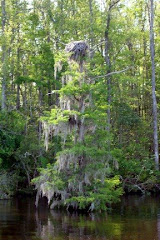

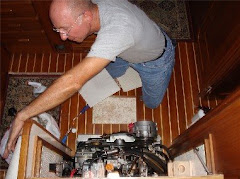







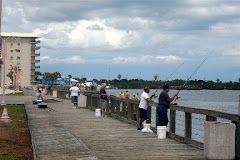









































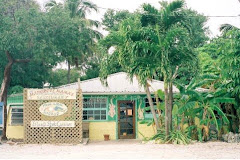









































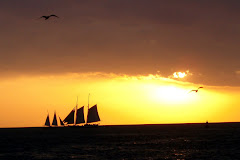




































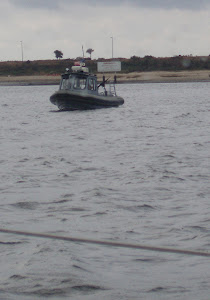
























































No comments:
Post a Comment